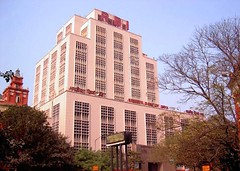Salt Lake, known as Bidhan Nagar, is one of Kolkata’s planned satellite towns. It is also the city’s IT hub. The municipality of Bidhan Nagar is located in North 24 Parganas. The territory is divided into sectors I through V and then into blocks. It is a well-developed neighborhood on the city’s northeastern outskirts.
Other well-known areas nearby are Salt Lake City, Kestopur, Lake Town, South Dum Dum, Baguiati, and Ultadanga. Much is horizontal construction, like detached homes and modest apartment buildings.
Salt Lake City is well-liked because it offers the best commercial and residential space. This area is always in high demand from prospective homebuyers from India and abroad because it has a wide range of residential units and upgrades with all necessary infrastructure. For many years, Salt Lake City observed the expansion of Kolkata’s real estate.
Are you looking for a home in Salt Lake City? An area with easy access to local hospitals and schools, good connectivity, and appropriate surroundings.
Reasons for investing in Salt Lake City in Kolkata
Connectivity
The E.M. Bypass links Salt Lake City to southern communities, and state buses connect all major routes. The Netaji Subash Candra Bose Airport and Bidhannagar Railway Station are also nearby and easily accessible via all forms of public transportation.
Infrastructure
The infrastructure of Salt Lake City is operated and developed by the KDMA (Kolkata Metropolitan Development Authority). It is also close to reputable hospitals, educational institutions, shopping malls, amusement parks, restaurants, retail spaces, and banks. Upcoming metro railways are also contributing to the growth and demand in this sector.
Landscape
Salt Lake City has all the nearby areas, such as the city center, and it’s enriched with residential units like independent bungalows and top-notch flats with all the amenities where people want to live their most comfortable lifestyle. Because it has the most reasonably priced residential flats and rental apartments, this area supports working professionals and students from other states. The most convenient location for living is there, and property values are rising. The region is split into several sections, including Salt Lake Sectors 1, 2, 3, 4, and 5. Sector 5 business centers support working professionals, whereas the other sectors have housing options for all demographics. The New Town and Rajarhat are both the closest to this location.
IT Hub
The numerous office buildings in Salt Lake City house all the top IT centers, including Tech Mahindra, Genpact, HCL Technologies, Siemens, TCS, and Wipro. While there is severe A-grade office space in cities like Bangalore, Chennai, and Mumbai, Salt Lake City has a sizable area for providing commercial spaces that are highly regarded by reputable technical players from India and abroad.
Places to Visit in Salt Lake, City Kolkata
Mother’s wax museum

It is known as the Madame Tussaud’s of Kolkata. It has gained popularity among both locals and visitors. Taking pictures next to life-size models of various personalities is entertaining. You’ll find wax statues of freedom fighters like Mahatma Gandhi, Subhas Chandra Bose, Jagdish Chandra Bose, Rabindranath Tagore, Kazi Nazrul Islam, singers such as Manna Dey, Lata Mangeshkar, and Kishore Kumar, actors such as Shahrukh Khan, and Salman Khan, sports legends like Diego Maradona and Sachin Tendulkar, and hugely popular movie characters including the likes of Harry Potter, Jack Sparrow, or the entire Avtar ensemble.
Eco Park

Eco Park is Kolkata’s largest park and offers a variety of exciting activities. If you come here the next time you’re looking for something to do, your day will be planned. You can play on trampolines, go biking or boating, take a toy train or even a buggy tour of the entire park, or just try to do it on foot. There is a sizable body of water where you can go kayaking, speed boating, and water and land zorbing. You can also practice ice skating, archery, and rifle shooting. A few cafes and restaurants are located within the park’s grounds where you can get a quick snack.
Central Park

Central Park, situated in Salt Lake City, is a beautiful green space. There is a trail that resembles a forest in the park that is practically unheard of elsewhere. It is a peaceful area, ideal for a stroll. When strolling, keep an eye out for a beautiful sunrise. The park is built around a sizable lake that offers boating access. Central Park is stunning with its never-ending, enormous, lush green lawns and variety of wildlife. Numerous aquatic birds, including egrets and lesser whistling ducks, live there. It also has some themed gardens, including a vibrant butterfly garden and a well-kept rose garden.
Salt Lake Stadium

Vivekananda Yuba Bharati Krirangan (VYBK), also known as Salt Lake Stadium, is a multi-use stadium in the Salt Lake neighborhood of Bidhannagar, with an 85,000 capacity. According to seating capacity, it is India’s second-largest stadium. There is nothing like enjoying a football game here. Everything is beyond anything you may have encountered, including the mass, the hollering, and the snacking.
Things to do in Salt Lake City, Kolkata
Get away with virtual reality.
Nothing’s better than VIREL if you are bored and want to escape into the virtual world. With their head-mounted display and special effects, VIREL, or virtual reality entertainment and leisure gaming cafe in Salt Lake, will ensure you experience the adventures of the closest possible reality with zombies, space monsters, and even army expeditions. This may become your favorite spot to hang out with friends and engage in new-age adventures.
Shopping
Salt Lake is one of Kolkata’s best shopping destinations when looking beyond the city’s vibrant market scene. The AMP Vaisakkhi Mall and City Center Mall are in Salt Lake City. Both of these malls offer many different establishments for a satisfying shopping experience. The food court and other restaurants also
offer delectable fare. While hanging out with your friends, watch a movie at the theater, play video games at the arcade, or just window shop.
Eat at the top international restaurants.
Since Salt Lake is one of Kolkata’s affluent neighborhoods, it makes sense that there are excellent restaurants there and nearby. Kolkata’s oldest and most popular Bengali restaurant is at 6 Ballygunge Place in Sector 1. You get to eat in a heritage bungalow over a century old, with walls covered in images of Calcutta. When in Salt Lake City, you should also check out Oudh 1590. This restaurant offers some of the best Mughlai food in the city and has an old charm.
Weekend Celebration
This neighborhood holds some of the city’s hottest new bars and nightlife venues. It’s only natural to want to end your day with some drinks and good music on the weekend. Raize the Bar has a microbrewery with four different types of craft beer. The venue’s large dance floor and live music are an excellent choice for a fun evening. You can also watch sports and mingle with a lively crowd. Check out our 10 Downing Street and Backstage pubs for guaranteed top-notch music, food, and drinks.
Communities to purchase residential flats in Salt Lake City
Ideal Aquaview, Salt Lake
Type of flats: 2, 3, 4 BHK
Area per flat: 1050-1950 sq. ft.
Ideal Aquaview is a beautiful residential community in Salt Lake City, Kolkata. It is a well-planned society with all of the necessary amenities. This property is part of an integrated township that encompasses 9 acres. In terms of the surroundings, it is very well maintained and clean.
The Ideal Aquaview is outfitted with all the modern amenities and facilities required to live a comfortable lifestyle. For the convenience of its residents, amenities such as a banquet hall, jogging and strolling track, outdoor tennis courts, flower gardens, guest accommodations, a kid’s play area, a library and business center, a meditation area, and multipurpose courts are available.
2. Karunamoyee Housing Society, Salt Lake
Type of apartments: 2, 3 BHK
Area per apartment: 680-1100 sq. ft.
Karunamoyee Housing Society is a well-thought-out residential development in Salt Lake City. It is a large-scale housing society of the highest quality. The proximity to major public infrastructures such as malls, educational institutions, and hospitals is the highlight of this society. It is also close to top consulting and IT firms in Salt Lake, which form the economic backbone of Kolkata.
Karunamoyee Housing Society provides basic amenities such as a clubhouse, security, maintenance staff, and a kids club to its prospective residents to offer comfort and convenience.
3. Sourav Abasan, Salt Lake
Type of apartments: 2, 3 BHK
Area per apartment: 892-1100 sq. ft.
One of Salt Lake City’s most aesthetically pleasing residential communities is Sourav Abasan. It is a relatively compact property with a 1-acre lot. The location is peacefully surrounded and designed to offer comfort. Sourav Abasan provides affordable residential apartments. Especially given the low cost of the housing.
This society includes all the amenities and facilities required for a simple modern lifestyle, such as a lift, reserved parking, security, visitor parking, maintenance staff, flower gardens, power backup, waste disposal, jogging, and a strolling path, to name a few.
4. Sun Helios Mansion, Salt Lake
Type of flats: 1, 2, 3 BHK
Area per flat: 464-1458 sq. ft.
Salt Lake City’s Sun Helios Mansion is a top-notch housing complex. This magnificent residence has been thoughtfully constructed and equipped with all the contemporary amenities required for a relaxed and comfortable lifestyle. As the name suggests, Sun Helios Mansion apartments are light and get a lot of sun during the day. It is also well-ventilated and airy.
To give potential residents a convenient place to live, Sun Helios Mansion includes amenities like a 24-hour water supply, 24-hour power backup, CCTV surveillance, covered parking, indoor games, a landscaped garden, a lift, a party area, rainwater harvesting, and security personnel.
5. GPS Meena Avalon
Type of flats: 2, 3 BHK
Area per flats: 902-1387 sq. ft.
GPS Meena Avalon is a residential society located in Salt Lake City. The many benefits of this property make this house a fantastic choice. It is enhanced by a prime location, a luxurious lifestyle, top-notch amenities, and healthy surroundings, making it even more alluring and impressive.
The interiors are equally stunning due to the designer tile flooring, granite countertops, contemporary sanitary fittings, and large windows for adequate lighting.
GPS Meena Avalon offers a variety of facilities, including a landscaped garden, earthquake resistance, CCTV surveillance, a gym, a play area, a lift, a clubhouse, parking, fire safety, a jogging track, 24-hour power backup, drainage and sewage treatment, table tennis, security, and 24-hour water supply. In addition, suitable security equipment is installed to guarantee the residents’ safety every day, every week.






